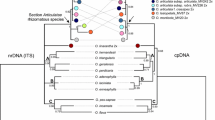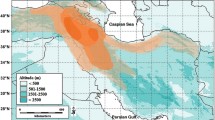Abstract
Complex geographical distribution patterns and agamospermy have united to obscure systematic relationships in the genusErigeron (400+ species). Sequence data were analyzed from the internal transcribed spacer region of nrDNA (ITS) and 5.8S cistron for 77 taxa including 63Erigeron species. Results support the North American origin ofErigeron and document thatAphanostephus, Conyza, and three small genera restricted to South America (Apopyros, Hysterionica, Neja) are all derived from withinErigeron. Phylogenetic data indicate that agamospermy has arisen at least three times inErigeron and that autogamy has evolved independently inConyza and inE. sect.Trimorpha.
Similar content being viewed by others

References
Axelrod D. I. (1973) History of the Mediterranean ecosystem in California. In: Di Castri F., Mooney H. (eds.) Mediterranean type ecosystems, origin and structure. Springer, New York, pp. 225–277.
Bain J., Jansen R. K. (1995) A phylogenetic analysis of the aureoidSenecio (Asteraceae) complex based on ITS sequence data. Plant Syst. Evol. 195: 209–219.
Baldwin B. G. (1992) Phylogenetic utility of the internal transcribed spacer of nuclear ribosomal DNA in plants: an example from the Compositae. Molecular Phylogenetics and Evolution 1: 3–16.
Baldwin B. G. (1997) Adaptive radiation of the Hawaiian silversword alliance: congruence and conflict of phylogenetic evidence from molecular and non-molecular investigations. In: Givnish T. J., Sytsma K. J. (eds.) Molecular evolution and adaptive radiation. Cambridge University Press, Cambridge, pp. 103–128.
Baldwin B. G., Sanderson M. J., Porter J. M., Wojciechowski M. F., Campbell C. S., Donoghue M. J. (1995) The ITS region of nuclear ribosomal DNA: a valuable source of evidence on angiosperm phylogeny. Annals of the Missouri Botanical Garden 82: 247–277.
Bandelt H. J., Dress A. W. D. (1992) Split decomposition: a new and useful approach to phylogenetic analysis of distance data. Molecular Phylogenetics and Evolution 1: 242–252.
Bateman A. J. (1948) Intra-sexual selection inDrosophila. Heredity 2: 349–368.
Battaglia E. (1950) L'alterazione dell meiosi nella riproduzione apomittica diErigeron karwinskianus var.mucronatus. Caryologia 11: 165–204.
Bayer R., Soltis D. E., Soltis P. S. (1996) Phylogenetic inferences inAntennaria (Asteraceae: Gnaphalieae: Cassiniinae) based on sequences from nuclear ribosomal DNA internal transcribed spacers (ITS). American Journal of Botany 83: 516–527.
Beals G. R. (1970) A study of apomixis inErigeron karwinskianus (Compositae, Astereae). Ph.D. Thesis, University of Cincinnati, Ohio, USA.
Botschantzev V. P. (1959)Erigeron. In: Komarov V. L. (ed.) Flora U.R.S.S., U.S.S.R. Academy of Sciences, Leningrad, pp. 191–288.
Bremer K. (1988) The limits of amino acid sequence data in angiosperm phylogeny and reconstruction. Evolution 42: 795–803.
Brummitt R. K. (1996) In defense of paraphyletic taxa. In: Van der Maesen L. G. J., van der Burgt X. M., van Medenbach de Rooy J. M. (eds.) The biodiversity of African plants. Proceedings of the XIVth AELFAT Congress, 22–27 August 1994, Wageningen, the Netherlands. Kluwer Academic Publishers, Dordrecht, pp. 371–384.
Campbell C. S., Wojciechowski M. F., Baldwin B. G., Alice L. A., Donoghue M. J. (1997) Persistent nuclear ribosomal DNA sequence polymorphism in theAmelanchier agamic complex (Rosaceae). Molecular Biology and Evolution 14: 81–90.
Cronquist A. (1943) The separation ofErigeron fromConyza. Bulletin of the Torrey Botanical Club 70: 629–632.
Cronquist A. (1947) Revision of the North American species ofErigeron, north of Mexico. Brittonia 6: 121–302.
Donoghue M. J., Cantino P. D. (1988) Paraphyly, ancestors, and the goals of taxonomy: A botanical defense of cladism. Botanical Review 54: 107–128.
Donoghue M. J., Olmstead R. G., Smith J. F., Palmer J. D. (1992) Phylogenetic relationships of Dipsacales based onrbcL sequences. Annals of the Missouri Botanical Garden 79: 333–345.
Doyle J. J., Doyle J. D. (1987) A rapid DNA isolation procedure for small quantities of fresh leaf tissue. Phytochemistry Bulletin 19: 11–15.
Eckenrode V. K., Arnold J., Meagher R. B. (1985) Comparison of the nucleotide sequence of soybean 18S rRNA with the sequences of other small-subunit rRNAs. Journal of Molecular Evolution 21: 259–269.
Farris J. S. (1989) The retention index and homoplasy excess. Systematic Zoology 38: 406–407.
Felsenstein J. (1985) Confidence limits on phylogenies: an approach using the bootstrap. Evolution 39: 783–791.
Francisco-Ortega J., Jansen R. K., Santos-Guerra A. (1996) Chloroplast DNA evidence of colonization, adaptive radiation, and hybridization in the evolution of the Macaronesian flora. Proceedings of the National Academy of Sciences, USA 93: 4085–4090.
Grant V. (1981) Plant speciation. 2nd edn. Columbia University Press, New York.
Gustafsson A. (1946–1947) Apomixis in higher plants. Lunds Universitets Arsskrift 42–43: 1–370.
Halliday G. (1976)Erigeron. In: Tutin T. G., Heywood V. H., Burges N. A., Moore D. M., Valentine D. H., Walters S. M., Webb D. A. (eds.) Flora Europaea. Vol. 4. Plantaginaceae to Compositae (and Rubiaceae). Cambridge University Press, Cambridge, pp. 116–120.
Harling G. (1951) Embryological studies in the Compositae. III. Astereae. Acta Horti Bergiani 16: 73–120.
Hillis D. M., Huelsenbeck J. P. (1992) Signal, noise and reliability in molecular phylogenetic analyses. Journal of Heredity 83: 189–195.
Hodges S. A., Arnold M. L. (1994) Columbines: a geographically widespread species flock. Proceedings of the National Academy of Sciences, USA. 91: 5129–5132.
Holmgren I. (1919) Zytologische Studien über die Fortpflanzung bei den GattungenErigeron undEupatorium. Kongl. Svenska Vetenskapsakademiens Handlingar 59: 1–118.
Holmgren P. K., Holmgren N. H., Barnett L. C. (1990) Index herbariorum. Part 1: the herbaria of the world, 8th edn. Regnum Vegetabile 120: 1–693.
Huber W. (1993a) Biosystematisch-ökologische Untersuchungen an denErigeron-Arten (Asteraceae) der Alpen. Veröffentlichungen des Geobotanischen Institutes der ETH, Stiftung Rübel, in Zürich 114: 1–143.
Huber W. (1993b) Zur Chemotaxonomie derErigeron-Arten (Compositae) der Alpen. Berichte des Geobotanischen Instituts der ETH Stiftung Rübel 59: 124–136.
Huber W., Leuchtmann A. (1992) Genetic differentiation of theErigeron species (Asteraceae) in the Alps: a case of unusual allozymic uniformity. Plant Syst. Evol. 183: 1–16.
Huber W., Zhang H. (1991) Morphologische und chemotaxonomische Untersuchungen an denErigeron-Arten der Alpen. Berichte des Geobotanischen Instituts der ETH Stiftung Rübel 57: 116–164.
Huson D. H. (1998) Splits Tree: analyzing and visualizing evolutionary data. Bioinformatics 14: 68–73.
Kim K.-J., Jansen R. K. (1994) Comparisons of phylogenetic hypotheses among different data sets in dwarf dandelions (Krigia): additional information from internal transcribed spacers sequences of nuclear DNA. Plant Syst. Evol. 190: 157–185.
Kim S.-C., Crawford D. J., Jansen R. K. (1996) Phylogenetic relationships among the genera of the subtribe Sonchinae (Asteraceae): evidence from ITS sequences. Systematic Botany 21: 417–432.
Kimura M. (1980) A simple method for estimating evolutionary rate of base substitutions through comparative studies of nucleotide sequences. Journal of Molecular Evolution 16: 111–120.
Kluge A. G., Farris J. S. (1969) Quantitative phyletics and the evolution of anurans. Systematic Zoology 18: 1–32.
Lane M. A. (1996) Pollination biology of Compositae. In: Hind D. J. N., Beentje H. J. (eds.) Proceedings of the International Compositae Conference, Kew, 1994. Royal Botanic Gardens, Kew, pp. 61–80.
Lane M. A., Morgan D., Suh Y., Simpson B. B., Jansen R. K. (1996) Relationships of North American genera of Astereae, based on chloroplast DNA restriction site data. In: Hind D. J. N., Beentje H. J. (eds.) Proceedings of the International Compositae Conference, Kew, 1994. Royal Botanic Gardens, Kew, pp. 49–77.
McDade L. (1992) Hybrids and phylogenetic systematics II. The impact of hybrids on cladistic analysis. Evolution 46: 1329–1346.
Moore D. M., Raven P. H. (1970) Cytogenetics, distribution, and amphitropical affinities of South AmericanCamissonia (Onagraceae). Evolution 24: 816–823.
Nesom G. L. (1976) A new species ofErigeron (Asteraceae) and its relatives in southwestern Utah. Brittonia 28: 263–272.
Nesom G. L. (1989a) The separation ofTrimorpha (Compositae: Astereae) fromErigeron. Phytologia 67: 61–66.
Nesom G. L. (1989b) Infrageneric taxonomy of New WorldErigeron (Compositae: Astereae). Phytologia 67: 67–93.
Nesom G. L. (1990a) Taxonomy of the genusLaennecia (Asteraceae: Astereae). Phytologia 68: 205–228.
Nesom G. L. (1990b) Further definition ofConyza (Asteraceae: Astereae). Phytologia 68: 229–233.
Nesom G. L. (1990c) Taxonomy of theErigeron coronarius group ofErigeron sect.Geniculactis (Asteraceae: Astereae). Phytologia 69: 237–253.
Nesom G. L. (1992a) Revision ofErigeron sect.Linearifolii (Asteraceae: Astereae). Phytologia 72: 157–208.
Nesom G. L. (1992b)Erigeron andTrimorpha (Asteraceae: Astereae) of Nevada. Phytologia 73: 203–219.
Nesom G. L. (1994a)Erigeron pattersonii (Asteraceae: Astereae), a new species from Nuevo Leon, Mexico. Phytologia 76: 96–100.
Nesom G. L. (1994b) Subtribal classification of the Astereae (Asteraceae). Phytologia 76: 193–274.
Nesom G. L., Zanowiak D. (1994) Taxonomic overview ofPodocoma (Astereae: Asteraceae), with the incorporation of two species fromConyza. Phytologia 76: 106–114.
Noyes R. D., Rieseberg L. H. (1999) ITS sequence data support a single origin for North American Astereae (Asteraceae) and reflect deep geographic divisions inAster s.l. American Journal of Botany 86: 398–412.
Noyes R. D., Soltis D. E. (1996) Genotypic variation in agamospermousErigeron compositus (Asteraceae). American Journal of Botany 83: 1292–1303.
Noyes R. D., Soltis D. E., Soltis P. S. (1995) Genetic and cytological investigations in sexualErigeron compositus (Asteraceae). Systematic Botany 20: 132–146.
Prithipalsingh, Dakshini K. M. M. (1974) Observations on the reproductive biology ofBlumea species (Asteraceae). American Journal of Botany 61 (Suppl.) 49.
Raven P. H. (1963) A flora of San Clemente Island, California. Aliso 5: 289–347.
Rieseberg L. H., Morefield J. D. (1995) Character expression, phylogenetic reconstruction, and the detection of reticulate evolution. In: Hoch P. C., Stephenson A. G. (eds.) Experimental and molecular approaches to plant biosystematics. Missouri Botanical Garden, St. Louis, pp. 333–354.
Roelofs D., van Velzen J., Kuperus P., Bachmann K. (1997) Molecular evidence for an extinct parent of the tetraploid speciesMicroseris acuminata andM. campestris (Asteraceae, Lactuceae). Molecular Ecology 6: 641–649.
Solbrig O. T. (1962) The South American species ofErigeron. Contributions of the Gray Herbarium of Harvard University 191: 3–79.
Spongberg S. A. (1971) A systematic and evolutionary study of North American arctic and alpine monocephalus species ofErigeron (Compositae). Ph.D. Thesis, University of North Carolina, Chapel Hill, USA.
Spooner D. M., de Jong D. C. D., Sun B.-Y., Stuessy T. F., Gengler K. M., Nesom G. L., Berry P. E. (1995) Chromosome counts of Compositae from Ecuador and Venezuela. Annals of the Missouri Botanical Garden 82: 596–602.
Stuessy T. (1990) Plant taxonomy. Columbia University Press, New York.
Tahara M. (1915) Parthenogenesis inErigeron annuus. Botanical Magazine (Tokyo) 29: 245–254.
Takaiwa F., Oono K., Sugiura M. (1985) Nucleotide sequence of the 17S–25S spacer region from rice rDNA. Plant Molecular Biology 4: 355–364.
Thompson J. D., Higgins D. G., Gibson T. J. (1994), CLUSTAL W: improving the sensitivity of progressive multiple sequence alignment through sequence weighting, position specific gap penalties, and weight matrix choice. Nucleic Acid Research 22: 4673–4680.
Turner B. L. (1984) Taxonomy of the genusAphanostephus (Asteraceae-Astereae). Phytologia 56: 81–101.
Wendel J. F., Schnabel A., Seelanan T. (1995) Bidirectional interlocus concerted evolution following allopolyploid speciation in cotton (Gossypium). — Proceedings of the National Academy of Sciences, USA 92: 280–284.
White T. J., Bruns T., Lee S., Taylor J. (1990) Amplification and direct sequencing of fungal ribosomal RNA genes for phylogenetics. In: Innis M. A., Gelfand D. H., Sninsky J. J., White T. J. (eds.) PCR protocols: a guide to methods and application. Academic Press, New York, pp. 315–322.
Yokota Y., Kawata T., Iida Y., Kato A., Tanifuji S. (1989) Nucleotide sequences of the 5.8S rRNA gene and internal transcribed spacer regions in carrot and broad bean ribosomal DNA. Journal of Molecular Evolution 29: 294–301.
Zardini E. (1981) Contribuciones para una monografia del géneroConyza Less. II. Rehabilitación del géneroLaennecia Cass. Darwiniana 23: 159–169.
Author information
Authors and Affiliations
Rights and permissions
About this article
Cite this article
Noyes, R.D. Biogeographical and evolutionary insights onErigeron and allies (Asteraceae) from ITS sequence data. Pl Syst Evol 220, 93–114 (2000). https://doi.org/10.1007/BF00985373
Received:
Accepted:
Issue Date:
DOI: https://doi.org/10.1007/BF00985373



